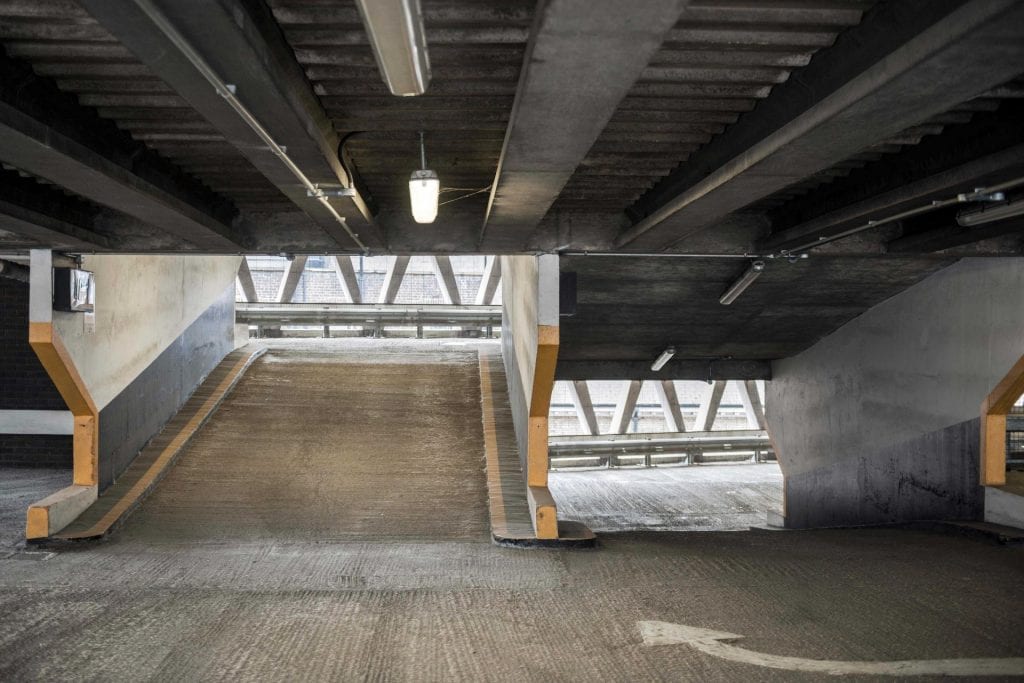Welbeck Street Car Park
By the Survey of London, on 22 February 2019
Earlier this month, it was announced that Westminster Council has approved plans to demolish the Welbeck Street Car Park. The following account of this arresting multi-storey car park was published in volume 51 of the Survey of London, part of a two-volume set on South-East Marylebone (2017) that was recently awarded the annual Colvin Prize by the Society of Architectural Historians of Great Britain.

Welbeck Street Car Park, view from the south (© Historic England, Chris Redgrave)
Occupying the sites of Nos 74–78, the Welbeck Street Car Park was part of the extensive redevelopment undertaken locally by Debenhams in the 1960s and 70s, beginning with head offices at 1 Welbeck Street opposite in 1962–4. Multi-storey car parks were not then new, but they still carried an air of novelty and offered scope for experimentation in design. Such a building fitted well into the modernization and rationalization of Debenhams overseen by the chairman and managing director John Bedford. Car parks, said Bedford, were ‘essential to the profitability of modern stores’, and lack of parking was behind the closure of a number of the groups’ provincial stores including that of Marshall & Snelgrove in his native Birmingham. Debenhams had in fact provided some parking before the war, at Mill Hill Place and Stratford Mews, but in any case the new car park was insisted upon by Westminster Council. Intended particularly for shoppers at Debenham & Freebody, Bradleys the furriers at 2 Welbeck Street, and Marshall & Snelgrove in Oxford Street, the project for 400-plus cars was announced at the end of 1963, but there was then a long delay before construction was carried out in 1970, to be completed the year after Bedford retired. Initially it seems to have been under-used despite the intensive local deployment of meters. [1]

The third level, looking south (© Historic England, Chris Redgrave)
The building was designed by Michael Blampied & Partners (F. D. Kahn and R. R. Le Duc being the architects in charge), with John de Bremaeker & Partners, structural engineers; the contractor was Cementation Construction Ltd. Though small, it is justly regarded as one of the most aesthetically accomplished buildings of its kind. Often described as Brutalist, it has little or nothing of that style. The exterior walls above the ground floor are built using triangular precast concrete units, carrying floors made up of precast concrete beams and slabs with a topping of reinforced concrete poured in situ. Split-level throughout on account of the sloping site, with a mezzanine over part of the ground floor, it has eight full upper floors for parking, including the rooftop. Most of the ground floor not required for vehicle entry and exit was given over to a restaurant, while most of the basement was designed as a cold store for Debenham & Freebody, to which it was linked by tunnel.

The third level, looking north-west (© Historic England, Chris Redgrave)
The obvious appeal is in the bright modular geometry of the wall units, enhanced by their load-bearing status; the disjunction caused by the split level, and the conventional colonnaded ground floor, show the practical limitations of the essentially sculptural approach. To save drawing time, the design of the modules was worked out with carved polystyrene blocks, and a full-size mock-up was used to test their draining and staining characteristics. The final units, made by the Atlas Stone Co. Ltd, incorporate drainage grooves at the junctions of the facets. Their overall scale is large, and the safety aspect of the openings is addressed by means of stainless steel wires threaded vertically through the building as a barrier, unseen from outside. [2]

Welbeck Street Car Park (© Historic England, Chris Redgrave)
In advance of a full online version of volumes 51 and 52 of the Survey of London, the draft chapters have been made freely available online. A volume on Oxford Street is set to be published next year.
References
[1] Financial Times, 6 December 1963, p. 15; 25 November 1968, p. 9; 19 January 1970, p. 9: Architects’ Journal, 18 August 1971, p. 358.
[2] Architects’ Journal, 18 August 1971, pp. 351–61: Builder, 9 April 1971, pp. 35–8: Concrete, vol. 6, 1972, p. 356: Simon Henley, The Architecture of Parking, 2007, pp. 125–31.
 Close
Close


